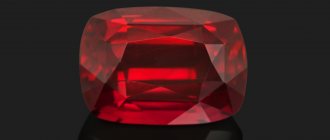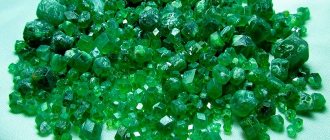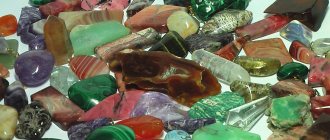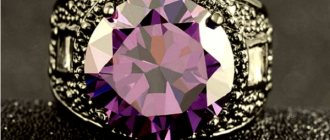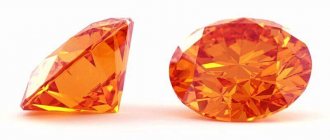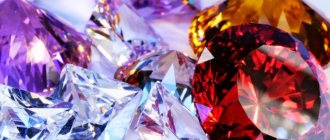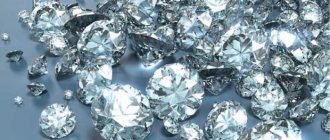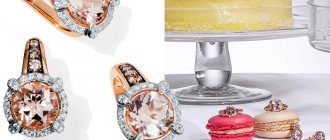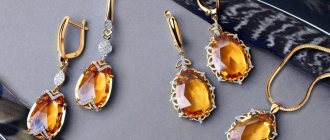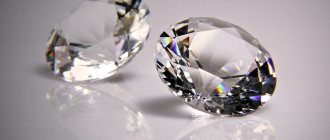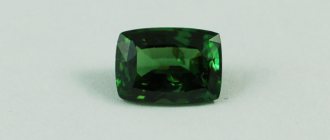What is the difference between precious and semi-precious stones, the main properties of precious stones are hardness, cleavage and density
Why are some precious stones valued more and others less, despite the fact that both semi-precious stones and real precious stones are, in general, the same minerals, processed and mined in the same way, and in their natural form they look exactly the same?
In fact, it will be very easy for a specialist in mineralogy to distinguish a real gemstone from an ornamental or semi-precious one; it is enough to know about the three key properties of precious stones.
Hardness and durability of gemstones
The hardness of gemstones is the resistance that the surface of a mineral exhibits when someone tries to scratch it with another mineral or other object, as well as the hardness when polished. To determine it, they use the Mohs scale of relative mineral hardness , named after Friedrich Mohs, a 19th-century German mineralogist.
Minerals with a scratch hardness of 8 to 10 on the hardness scale have “gem hardness.” Hardness is very important when identifying gemstones. For example:
- Plaster (hardness 2) – easily scratched even with a fingernail.
- Glass (hardness 5.5-6) – scratched by quartz
- Quartz (hardness 7) – scratched by topaz
- Topaz (hardness
 – scratches with corundum
– scratches with corundum - Corundum (hardness 9) – can be scratched by diamond
- Diamond (hardness 10) – not scratched by anything
At the same time, the hardness of precious stones in itself is not a defining characteristic - moreover, it is not the same for different faces and directions of grinding (how did you think diamonds are processed differently? :)). Therefore, “according to science,” not just hardness is determined, but absolute hardness is determined when a gemstone is polished in water and the amount of substance removed from the surface of the sample is measured.
Diamond or corundum tips are the “technical” versions of jewelry gemstones
The hardness of a gemstone can be determined quite accurately by its color, and in the old days, when there was no precise equipment yet, this method was the only one.
For example, red and blue stones are equivalent and very expensive (rubies and sapphires), and from the point of view of mineralogy they actually have the same hardness of 9 and are varieties of corundum (“yakhont”, as it was commonly called).
Hardness allows us to answer the question:
Why do gemstones become cloudy?
If you turn to the Mohs mineral hardness scale and look for quartz in it, you will find that this modest stone has a fairly high hardness of 7. Quartz is interesting because it can crumble into tiny particles that constantly surround us - like in the form of sand ( Have you noticed how its quartz particles shine?) and in the form of dust.
Over time, “soft stones” (and glass), having a hardness below 7, under the influence of dust and careless care, undergo a process of “reverse polishing” - dust, or rather the quartz contained in it, acts on their edges like sandpaper.
Of course, the effect of this insidious mineral does not apply to rubies, sapphires and diamonds.
Precious variety of corundum
Natural corundum is a very hard mineral, second only to diamond in hardness. Corundum is a mineral which is also called ruby and sapphire which are very expensive stones and that is why corundum stone is used in jewelry. Ruby corundum is a red-colored variety of corundum mineral, and any corundum mineral of a different color is classified as sapphire.
Red corundum stone
The word corundum comes from the ancient Hindu word korund, which is unknown what it meant, but it was later used to refer to stones brought from India to Europe. In its pure form, this mineral is colorless, but due to the presence of other minerals in its composition, corundum acquires color. In its pure colorless form, the mineral is very rare in nature, but other varieties of corundum such as yellow, green, blue, lilac, white, violet are very common.
Yellow corundum is a natural stone
Yellow corundum has the greatest hardness. However, if you look closely at the color of corundum, it becomes clear that it consists of layers of different colors that give the stone a certain shade. For example, purple corundum consists of a large number of blue and red layers, and blue corundum consists of yellow and blue layers. Some stones have a special crystal structure, and if they are cut into a cabochon, this structure will produce a bright, light six-pointed star. In nature, precious corundum is mainly found in small sizes. Very often, very fine, usually in powder form, is used in industry as an abrasive material.
Blue corundum stone photo
Corundum has the chemical formula Al2O3, and in its chemical composition it is alumina with an admixture, that is, aluminum oxide and a small amount of chromium, ferric iron and other metals. The red color of the stone is mainly given by chromium, and the blue color is given to the stone by titanium. Of the red flowers, the most valuable color is considered to be pigeon's blood, a red color that has a faint purple tint. The spectrum of red colors is very large and therefore, in order to create a color boundary between rubies and sapphires, starting with light red color, stones are classified as sapphires.
Purple corundum stone photo properties
The colorless transparent variety of corundum does not give a reflection and therefore such stones are not of interest to jewelers. Corundum crystals belong to the holohedral class of trigonal system. Corundum crystal lattice is usually found in two types. The first type includes rubies in which the crystal has large faces and is found in the shape of a triangle related to the basopinacoid in combination with six faces of a prism and six faces of the main rhombohedron. The second type includes sapphires in which the crystal has twelve pyramid faces that form an equatorial belt.
Corundum green
- Almost all precious varieties of corundum have a birefringence of 0.008, and green corundum can have even 0.009.
- The refractive index for an ordinary ray ranges from 1.768 to 1.778, and for an extraordinary ray from 1.76 to 1.77. Since the refractive index of an extraordinary beam is less than that of an ordinary one, any type of corundum is optically negative.
- It has one optical axis which is located perpendicular to the basopinacoid and parallel to the edges of the prismatic faces.
- The variance for the interval B - G is 0.018.
- It has a distinct and characteristic dichroism, which for an ordinary beam appears in a deep and beautiful color, and for an extraordinary beam it appears in a pale color. Corundum of blue color for an ordinary ray has a deep blue color, and for an extraordinary ray it has a yellowish-blue color. Red corundum for the ordinary ray has a deep purple-red color, and for the extraordinary ray it has a pale yellowish-red color.
- When heated, corundum becomes lighter in appearance, causing pale purple and yellow stones to become colorless and purple stones to become pink.
- When irradiated, its color becomes saturated and even colorless ones can acquire some color depending on the chemical composition of corundum.
- Transparent corundum has a glassy luster.
- Red stones have a fluorescent doublet that is located in the red region of the visible spectrum.
- The density of corundum ranges from 3.94 to 4.1.
- The hardness of corundum on the Mohs scale is number 9.
- It has a separation that is usually parallel to the plane of the basopinacoid and in rare cases parallel to the faces of the main rhombohedron.
When processing corundum, close attention must be paid to the symmetry of the crystal. Previously, they were given a step cut, but nowadays they are given a diamond and mixed cut, that is, diamond on top and step on the bottom. The use of corundum is developed not only in jewelry but also in watches, high-precision instruments and even as an abrasive material. Large red corundum stones are very rare in nature and therefore are very expensive, while large precious blue corundum stones and stones of other colors are more common and therefore they are cheaper than red ones.
Pink corundum
The British Museum displays several examples of historical large corundum wares;
- The sapphire rose from the collection of Sir Gus Sloan has an octagonal outline. It is 19 mm in diameter and weighs 31.5 carats. This rose, along with other rubies and emeralds, adorned a quartz button.
- A corundum crystal in the shape of a Buddha figurine is attached to a gold pin.
- Broken Burmese ruby crystal. This stone weighs 690 grams and measures 12 cm across. This stone is brilliant cut above the waist and step cut below. It formerly belonged to the Duke of Devonshire.
Russian regalia include stones such as;
- Cornflower blue sapphire weighing 250 carats. This stone is 2.2 cm high and varies in diameter from 3 to 3.4 cm.
- Corundum is a red stone in the shape of a pigeon egg. This stone belonged to King Gustav Adolf of Sweden. In 1777, during the visit of the King of Sweden to St. Petersburg, he presented this stone to Empress Catherine II. It later turned out that this was a pink tourmaline of medium quality weighing 250 carats. Currently it is in the diamond fund in Moscow.
In Paris, the Jardin des Plantes collection contains two untreated sapphires.
- The first brownish color was called Rospoli. It weighs 135 carats.
- The second measures 5 cm in length and 3.8 cm in thickness.
There are several stones in the American Museum of Natural History in New York.
- A large sapphire weighing 163 carats and a yellow one weighing 100 carats were found in Ceylon.
- A purple stone brought from Thailand weighing about 34 carats.
- Also in this museum there is a golden-yellow stone that weighs 75.4 carats.
- The museum also houses 3 largest star stones. The first star corundum is the Edith Haggin de Long ruby, weighing 100 carats. Its dimensions are 3.8 cm in length and 2.5 cm in diameter. The second star sapphire, the Star of India, weighs 563 carats. The third star sapphire is the lilac Midnight Star, weighing 116 carats.
Ruby can easily be confused with spinel or almandine garnet. But spinel, like almandir garnet, does not have birefringence and therefore can be easily distinguished from corundum. Also, natural corundum stone can be easily distinguished from other stones by its high density and bright lines in the absorption spectrum.
Sapphire corundum is a natural stone
In nature, corundum deposits occur in the form of veins and segregations of various igneous rocks, as well as as a product of contact-metamorphic processes. The most valuable stones are found as crystals in crystalline limestones or as pebbles in alluvial deposits. Almost all rubies are found in ruby mines that are located near Mogok located in upper Burma, approximately 145 km northeast of Mandalay at an altitude of approximately 1200 meters above sea level. In 1929, a large corundum weighing 958 carats was found on the surface of the earth directly under the grass cover. This stone was called the Jewel of the Jungle. The jewelers did not know how to cut this sapphire and as a result they divided it into 9 parts. Good red stones are found in Thailand near Bangkok. Thai stones are much darker than Burmese stones and therefore experts can determine their deposit by their color. Brown corundum with a characteristic silky structure is also found in Thailand. In India, stones in the form of sapphires are found in different places, but the largest deposit of corundum is considered to be the Zaskar Range, which is located in the northwestern Himalayas in Kashmir. In the USA, in the state of Montana, deposits of corundum were discovered in the form of sapphires that retain their color under artificial light, and in the state of North Carolina, about 10 km north of Franklinton, red corundum of medium quality was found near the Cowie Creek. In Australia, near Anaka in Queensland, jewelry corundum of all types was discovered. In Zambia, near Samobula, stones are also occasionally found in productive pebbles. In Tanzania, 80 km from Tanza on the Umba River, opaque ruby corundum was found.
Jewelry Appraisal
In our educational practice, we quite often come across phrases from representatives of pawnshops, purchases, and retail that they do not work with stones, do not evaluate or describe them, which means they do not need knowledge of the issues of diagnostics of precious stones. It is worth noting that this position is fundamentally incorrect and carries significant financial risks for organizations and individual entrepreneurs involved in the circulation of precious metals and precious stones (manufacturers, sellers, buyers, pawnshops, etc.). Why it is necessary to identify and take into account precious stones, where this obligation is recorded and what the consequences of violation are. I will try to briefly answer these questions in this article.
Why and where was it recorded?
Firstly
, are subject to registration and description in accordance with the requirements of the current legislation - precious stones - diamonds, emeralds, rubies, sapphires and alexandrites, natural pearls, unique amber formations (Article 1 Federal Law of March 26, 1998 N 41-FZ “On Precious Metals and precious stones"), mandatory accounting of jewelry stones is not provided for by current legislation.
Secondly
, the legislation does not indicate that inserts in jewelry are not subject to accounting and description (and over the past 17 years there has been no such indication in regulatory sources), they are described by manufacturers and retailers, the legislation does not contain exceptions for pawnshops and purchases - “Accounting precious stones in all types and conditions, including precious stones included in purchased components, products, instruments, tools, equipment, weapons, military equipment, materials, semi-finished products (including those purchased abroad) and contained in waste precious stones, as well as in products made from them, is carried out by organizations at all stages and operations of technological, production and other processes related to their use and circulation" (Article 5 Order of the Ministry of Finance of Russia dated December 9, 2016 N 231n "On approval of the Instructions on the procedure for accounting and storage precious metals, precious stones, products made from them and maintaining records during their production, use and circulation”).
After these arguments, I often hear why this applies to pawnshops or purchasing - circulation of precious stones - trade, transportation, forwarding, collateral transactions, transactions made by banks with individuals and legal entities, receipt, storage (Article 19.14 of the Code of Administrative Offenses of the Russian Federation).
Third
, for the accounting and description of precious stones there are clearly defined parameters (not only monetary ones), keeping records and descriptions without all the required parameters is a violation. Adjustable:
- For all enterprises, accounting of precious stones during their use and circulation is carried out by name, weight (in grams, carats), quality (color and purity), as well as in value terms (Article 8 Order of the Ministry of Finance of Russia dated December 9, 2016 N 231n “On approval of the Instructions on the procedure for recording and storing precious metals, precious stones, products made from them and maintaining records during their production, use and circulation”).
- For purchase - the receipt indicates ... the name of the precious stones, their quantity and weight, the contract price per carat, the cost, including in relation to: large diamonds (from one carat and above), medium ones (from 0.30 to 0.99 carats ), emeralds, sapphires, rubies, alexandrites - also their size - weight group, color and purity group; rose cut diamonds, small diamonds (up to 0.29 carats) and simplified cut diamonds - also their color and clarity group; natural and cultured pearls - the number of pearls and their weight (p.p.d) clause 13 Decree of the Government of the Russian Federation dated 06/07/2001 N 444 “On approval of the Rules for the purchase of jewelry and other household products made of precious metals and precious stones and such scrap from citizens products")
- For retail – Jewelry and other products made of precious metals and (or) precious stones put up for sale must... have sealed labels indicating the name of the product and its manufacturer... the type and characteristics of the inserts, including the processing method that changes the quality, color and cost characteristics of the precious stone (clause 64 of the Government of the Russian Federation of January 19, 1998 N 55 “On approval of the Rules for the sale of certain types of goods, the list of durable goods that are not subject to the buyer’s requirement to provide him with a free supply for the period of repair or replacement of a similar product, and a list of non-food products of good quality that cannot be returned or exchanged for a similar product of a different size, shape, size, style, color or configuration")
- for a pawnshop - a pawn ticket must contain the following provisions and information... the name and description of the pledged item, allowing it to be identified, in accordance with the requirements of the legislation of the Russian Federation (clause 3, clause 5, article 7, Federal Law of July 19, 2007 N 196- Federal Law “On Pawnshops”), legal requirements see paragraph 2 of this paragraph (for all enterprises).
Fourth
, any precious stones are subject to accounting, regardless of their size, the error in determining the size of precious stones is established for stones regardless of their size, shape (including fastening in jewelry) - The weight of diamonds and processed precious stones is determined in carats on scales, providing the necessary weighing accuracy. The weighing error, depending on the weight being weighed, should be: for a weight of up to 1000 carats no more than 0.01 carats (Article 46 Order of the Ministry of Finance of Russia dated December 9, 2016 N 231n “On approval of the Instructions on the procedure for accounting and storage of precious metals, precious stones, products of them and maintaining records during their production, use and circulation")
Fifthly
, not a single regulatory document states that only special experts or gemologists with specialized higher education can identify and take into account precious stones, it is worth noting that today in Russia 21 samples of precious metals are officially recorded, their predominant quantity is easily determined by retail specialists , purchases, pawnshops without specialized higher education and expert qualifications, but there are many times fewer precious stones, and diagnostic methods, including instrumental ones.
At sixth
, organizing the assessment of precious stones at an enterprise is an inexpensive pleasure - on average, the cost of a set of diagnostic equipment (depending on the chosen methods and budget) ranges from 20,000 to 60,000 rubles (such equipment will last for 5-10 years and does not need to be updated as reagents), to always help you when carrying out determination, assessment and accounting - laboratories of training centers and territorial State Hygiene Institutes.
What is the threat?
Incorrect description of a gemstone or failure to describe a gemstone is a violation of current legislation, including affecting consumer rights.
- To account for (all) – Article 19.14.
Violation of the rules for the extraction, production, use, circulation, receipt, accounting and storage of precious metals, pearls, precious stones or products containing them. Violation of the established rules for the extraction, production, use, circulation (trade, transportation, forwarding, collateral transactions, transactions made by banks with individuals and legal entities), receipt, accounting and storage of precious metals, pearls, precious stones or products containing them - entails the imposition of an administrative fine on officials of organizations carrying out transactions with precious metals, precious stones in all types or products containing them - from ten thousand to fifteen thousand rubles; for legal entities - from thirty thousand to fifty thousand rubles.
- For pawnshops - Article 15.26.2.
Violation of the legislation of the Russian Federation by the pawnshop. Violation by a pawnshop of the legislation of the Russian Federation on pawnshops - entails the imposition of an administrative fine on officials in the amount of ten thousand to thirty thousand rubles; for legal entities - from fifty thousand to one hundred thousand rubles.
- For retail - Article 14.15.
Violation of the rules for the sale of certain types of goods. Violation of the established rules for the sale of certain types of goods - entails a warning or the imposition of an administrative fine on officials - from one thousand to three thousand rubles; for legal entities - from ten thousand to thirty thousand rubles.
Article 14.7.
Consumer deception. Misleading consumers regarding the consumer properties or quality of a product (work, service) during the production of goods for marketing purposes or when selling a product (work, service) - entails the imposition of an administrative fine on officials - from twelve thousand to twenty thousand rubles; for legal entities - from one hundred thousand to five hundred thousand rubles.
Article 14.8
. Violation of other consumer rights. Violation of the consumer's right to receive necessary and reliable information about the product being sold - entails a warning or the imposition of an administrative fine on officials in the amount of five hundred to one thousand rubles; for legal entities - from five thousand to ten thousand rubles.
As a conclusion, I would like to note that the identification and accounting of precious stones today is an area covered with a huge number of stereotypes; in order to minimize the financial risks of an enterprise and its employees, it is necessary to strive to organize a correct system for identifying and accounting for precious stones (in fact, as well as an organization system diagnostics of precious metals), and this is, first of all, education (of the manager and his employees), tracking changes in the features of diagnostics of precious stones (as continuous training), cooperation with diagnostic laboratories and State Institute of Inspectorate.
Director of the ULC Pospelova M.N.
